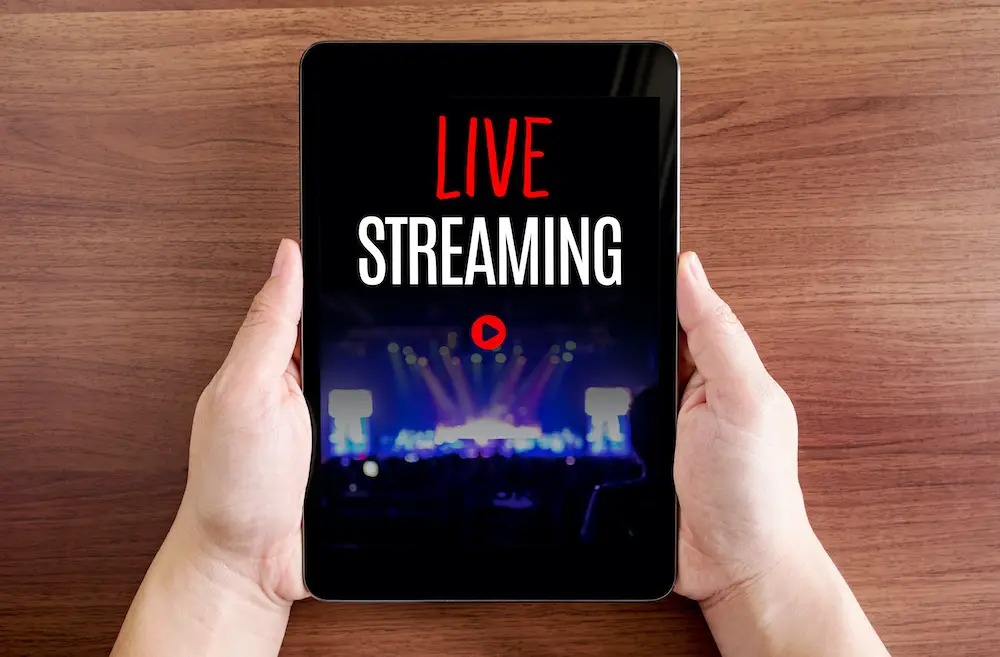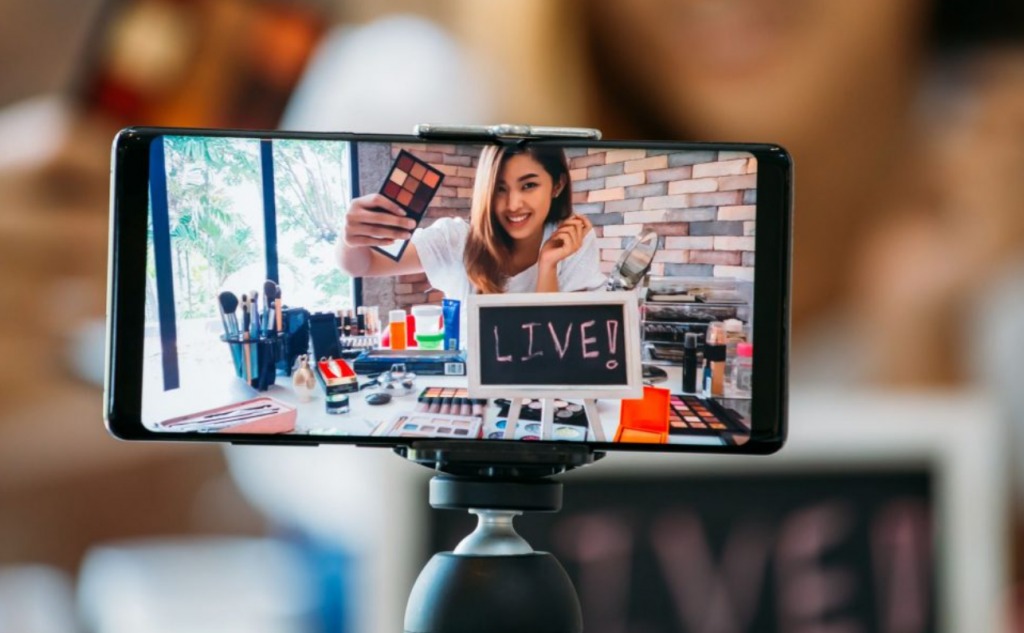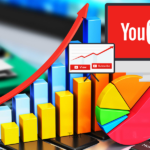Live streaming is wildly popular. As a result, live streaming has opened up a whole new world of opportunities for businesses, brands, affiliate marketers, digital marketers, and influencers at every level.
Today, there are more live streaming video sites and platforms that support this live video footage option. It’s so popular that this video creation solution is expected to snowball quickly over the coming years.
YouTube Live and Twitch, along with other platforms, offer streaming software that one can embed into their blogs or websites, which lets live streamers create streams of income resulting from their content.
Video on Demand or VoD streaming has become highly competitive, but live streaming still has potential with less competition overall. It’s more of an up-and-coming market, so it’s wise to get into it now.
Even though live streaming is popular, it’s in its infancy, but it’s not without an audience that is growing. The trends for live streaming are not about to slow down.
In the next few paragraphs, we will offer an extreme list of useful live streaming statistics that will open your eyes to this market, and that you can use to create a live streaming strategy.
If you’re thinking of getting into this live streaming deal, the statistics and facts below will help you discover how to be successful in your business through live streaming.
Post Contents
- 1 Key Live Streaming Statistics 2024
- 2 Live Streaming Statistics: Market Size in 2024
- 3 Live Streaming Statistics According to Age Groups 2024
- 3.1 4. It’s the Millennial Age Group (18 to 34) that Tend to View Live Streams the Most at 63%.
- 3.2 5. Where Baby Boomers and Gen X-ers Watch More Broadcast Television, Millennials, and Gen Z-ers Watch More Streaming Content.
- 3.3 6. 34% of Gen Z-ers Are Attracted to Social Media Platforms Due to The Live Streaming Feature.
- 4 Live Streaming Statistics and Mobile Viewing 2024
- 5 Live Streaming Statistics for Drawing Attention 2024
- 5.1 10. According to Research, Start Times and Buffering Are Better on Live Streaming than VoD.
- 5.2 11. 26.4 Minutes Is the Average Per-Session Watch Time for Live Streams.
- 5.3 12. Live Videos Are More Attention-Grabbing and Holding by As Much as 10 to 20 Times Longer than Other Forms of Video Content.
- 5.4 13. when It Comes to Daily Live Streams, 70% of Viewers Watch Them Every Day.
- 6 Statistics on the Challenges of Live Video Streaming 2024
- 6.1 14. The Percentage of Live Stream Failure Is 2.6% of All Cases.
- 6.2 15. The Abandonment Rate on Live Videos Is 6% as A Result of Taking Longer than Two Seconds to Load.
- 6.3 16. The Biggest Challenges for Live Streamers to Overcome Include 41% of Employees Not Tuning Into the Stream, 36% Not Grasping the Need for Ample Bandwidth and The Repercussions from Lack of Bandwidth, and 39% Not Remote Streaming at Conferences.
- 6.4 17. Revenues Are Impacted when The Quality of An Over the Top, (OTT) Platform Degrades.
- 7 The Uses of Live Streaming Videos in 2024
- 7.1 18. Content Creators and Influencers Using Live Video Streaming Have More than Doubled Their Engagement.
- 7.2 19. The 2019 Coachella Event Is the Highest Live-Streamed Event Ever with 82.9 Million Live Viewers Attending.
- 7.3 20. Calling Into Customer Support Has Been Reduced by 43% Because of Online Video Content.
- 8 FAQs
- 8.1 What Has Made Live Streaming so Popular?
- 8.2 What’s the Difference Between Video-On-Demand and Live Streaming Video?
- 8.3 Who Are the Live Video Streaming Viewers?
- 8.4 What’s the Deal with Social Media and Live Streaming?
- 8.5 What’s up With Live Video Streaming for Gaming?
- 8.6 What Are Other Live Streaming Factors to Consider?
- 9 Conclusion
- 10 Sources
Key Live Streaming Statistics 2024
- Video content on Facebook Live became 32% more important in business marketing strategies.
- The market valuation for live video streaming by 2027 is projected to be as much as $184.27 billion.
- Exclusive live coverage of a topic accounts for 26% of people who watch live streams.
- It’s the Millennial age group (18 to 34) that tend to view live streams the most at 63%. 34% of Gen Z-ers are attracted to social media platforms due to the live streaming feature.
- 34% of Gen Z-ers are attracted to social media platforms due to the live streaming feature.
- 16 minutes is the average time people watch streaming videos on their mobile device
- By 2022, mobile use is expected to account for about 79% live streaming.
- According to research, start times and buffering are better on live streaming than VoD.
- Live videos are more attention-grabbing and holding by as much as 10 to 20 times longer than other forms of video content.
- Content creators and influencers using live video streaming have more than doubled their engagement.
Live Streaming Statistics: Market Size in 2024

1. Video Content on Facebook Live Became 32% More Significant in Business Marketing Strategies.
When Facebook Live was first launched, it got a lot of attention right away.
Since that time, it has quickly begun to play a significant role in many businesses today when they are creating their marketing strategies. Live video is quickly becoming essential.
Live streaming videos let businesses, brands, affiliate marketers, etc.
Show their offerings, behind-the-scenes operations, and other content of themselves or their employees at work in real-time.
It’s like taking a personal tour through a company =, individual, or other organization. Facebook’s algorithms place a higher priority on live video streaming content.
As a result, it allows businesses to engage with their audience in conjunction with attractive new and organic traffic.
2. The Market Valuation for Live Video Streaming by 2027 Is Projected to Be as Much as $184.27 Billion.
According to statistics, this market will achieve a value of $184.27 billion by 2027. We shall see soon enough.
Live videos are rising in popularity across platforms for content like concerts, video games, tutorials, meditation music, retail selling, and more.
This estimated valuation of the industry is only a few years away, but it shows how huge ‘going live’ on a platform will become in the future.
Now is the time to jump on this bandwagon.
3. Exclusive Live Coverage of A Topic Accounts for 26% of People Who Watch Live Streams.
People are drawn to exclusive content because it’s not always accessible by everyone. People are simply attracted to exclusivity in certain areas. In this instance, it’s live streaming content.
Exclusive live video streaming content can provide an audience with learning something new. It’s being used for many teaching opportunities and for other informational purposes.
Live Streaming Statistics According to Age Groups 2024
4. It’s the Millennial Age Group (18 to 34) that Tend to View Live Streams the Most at 63%.
According to live video statistics, Millennials spend more time watching content on live streaming platforms.
Millennials grew up being exposed to conventional methods of video watching and communication platforms, but now they are leaving these platforms for live streams.
One reason may be because they enjoy connecting with others in the real-time environment over reading updates that are often not offered for hours or days after publication.
5. Where Baby Boomers and Gen X-ers Watch More Broadcast Television, Millennials, and Gen Z-ers Watch More Streaming Content.
The way humans consume media content has gone through a lot of changes in the past several years.
For instance, when televisions were made available to the public, they quickly became an essential part of family life. It’s how most families enjoyed their quality time.
This is now a very rare occurrence in most households.
Today, VoD and live streaming is becoming popular among the newer generations. In part, this is due to how convenient it is to watch streaming videos on your phone, computer, or tablet.
You may still see televisions in many homes today, but the younger generation has fewer TVs because they watch on other devices.
6. 34% of Gen Z-ers Are Attracted to Social Media Platforms Due to The Live Streaming Feature.
About one-third of Generation Z-ers have social media accounts on platforms like Twitter, Facebook, Instagram, etc.
They are on these platforms almost exclusively for one reason, which is to watch streaming video content.
As many as 34% of people in the Generation Z category say they use social media primarily for live streaming features.
Before this phenomenon, Gen Z-ers were using social media to post images, memes, and photos and to connect with their counterparts, friends, relatives, and game buddies.
Today, they prioritize live streaming platforms for essentially the same reason. They want to connect with others in an alternate visual fashion.
Live Streaming Statistics and Mobile Viewing 2024
7. 16 Minutes Is the Average Time People Watch Streaming Videos on Their Mobile Devices.
The convenience of mobile devices like smartphones and tablets allows people to watch videos on them more than other devices like laptops or desktops, as we will also address in this section.
The reason for this could be that mobile devices are mobile and portable. You can fit them in a purse, pocket, or small bag. It’s certainly something that helps you pass the time waiting in line or at the airport.
Fortunately, smartphones and tablets offer versatility and functionality that allow for video viewing.
8. By 2022, Mobile Use Is Expected to Account for About 79% Live Streaming.
According to live streaming statistics, nearly 80% of live streaming will be spent using a mobile phone or device.
With more people using smartphones and other mobile devices including cars, watches, and even televisions, this industry can expect more growth in views on such devices.
This has opened up the world of watching videos to the world no matter where you are. The days of using your cell phone for exclusively sending text messages are over.
9. The Length of Time for Live Streaming on A Desktop Is 7 Minutes
As discussed in number 7, mobile devices account for an average of 16 minutes in watch time for live streams and videos. The minutes spent on a desktop is just under half of that.
It’s uncommon for people to watch video content on their desktops. It’s thought to be due to living hectic lives or being on the go.
So, the average time of 7 minutes for watching a video on a desktop should not come as a surprise.
Live Streaming Statistics for Drawing Attention 2024

10. According to Research, Start Times and Buffering Are Better on Live Streaming than VoD.
Technology has become more sophisticated over the years. When live streaming was first introduced, all sorts of issues like lag, buffering, latency, and buggy stuff occurred. This didn’t make for the best viewer experience.
Due to more advanced technology and programming, live streaming today has vastly improved with much shorter buffering.
As a matter of fact, live streams today offer higher quality, shorter buffering time, and faster playback than VoD.
Today’s live video streaming experience is much better. This is probably why it’s more popular today than ever.
11. 26.4 Minutes Is the Average Per-Session Watch Time for Live Streams.
The latest statistics show that the current average time in minutes for live video watch sessions is 26.4 minutes, which is nearly 30 minutes.
This is likely due to the fact that these sessions allow people to engage with live broadcasts that provide a detailed experience.
People are likely to tune in longer when the sessions are relevant and good. What a great takeaway for companies looking to advertise in live streaming broadcasts.
12. Live Videos Are More Attention-Grabbing and Holding by As Much as 10 to 20 Times Longer than Other Forms of Video Content.
The average attention span of people today has become shortened due to the use of smartphones, computers, and other technology. That said, it takes interesting content to keep their attention.
Live streaming statistics show that live videos are becoming the best way to grab attention and keep people engaged. It seems to be the best method for getting viewers to watch longer.
Research shows that people are 10 to 20 times more apt to watch live streaming content than any other type of video.
It may be the real-time, authentic nature of this type of video content. After all, it’s not pre-recorded or edited. It’s raw and real.
13. when It Comes to Daily Live Streams, 70% of Viewers Watch Them Every Day.
When people keep coming back for more of your live streaming content, they tend to watch every day, if you upload daily content.
The live streaming audience is a loyal and hardcore audience that can hardly wait for your next presentation.
Statistics on the Challenges of Live Video Streaming 2024
14. The Percentage of Live Stream Failure Is 2.6% of All Cases.
Nothing is perfect, including live streams. These videos don’t always come off like you plan. However, failure is at a very low percentage, so it shouldn’t alarm you. It’s a minor issue.
The popularity of live streaming could be partially due to the reliable nature of this kind of video content.
15. The Abandonment Rate on Live Videos Is 6% as A Result of Taking Longer than Two Seconds to Load.
Live streaming statistics tells us that if your live stream takes longer than two seconds to load, 6% of viewers will leave it.
That is also a low percentage, but hopefully not something that significantly impacts your presence.
What this does show, is the low level of patience coming from viewers for watching live streams.
It also proves that society has become one of instant gratification, the craving of instant content, and the lack of patience in waiting even for the best content.
So, you can take away from this the fact that viewers are only willing to wait two seconds for your live stream to load before they deem it unworthy of their time.
16. The Biggest Challenges for Live Streamers to Overcome Include 41% of Employees Not Tuning Into the Stream, 36% Not Grasping the Need for Ample Bandwidth and The Repercussions from Lack of Bandwidth, and 39% Not Remote Streaming at Conferences.
Live streaming comes with challenges just like all kinds of technology. Most of these challenges arise from the use of live streaming in different locations.
Some businesses or people simply are unaware of the limits of bandwidth that can create streaming issues like lag and freezes.
Adjusting these glitches is an issue when you’re in the middle of viewing important information.
If you’re in a remote location, it’s difficult to get people to find the proper stream.
Live video streaming challenges are to be overcome by those providing the content. That is how you provide the best experience for your viewers.
17. Revenues Are Impacted when The Quality of An Over the Top, (OTT) Platform Degrades.
If there is an issue with quality degradation on an OTT platform, revenue can be impacted, lowering it by one quarter.
Quality is something that most live streamers prioritize. Viewers insist on quality and an overall good experience.
When OTT platforms fail to provide quality in their live streams, their viewership will drop, which will lower their revenue by up to 25%.
Depending on your revenues and needs, that’s significant. No one wants to lose a quarter of their revenue.
The takeaway from this live streaming statistical data should be the importance of providing high-quality live video streaming content.
The Uses of Live Streaming Videos in 2024

18. Content Creators and Influencers Using Live Video Streaming Have More than Doubled Their Engagement.
Influencers are the face of products or services. So many of these social media influencers demonstrate products through a live stream.
Putting a face to a product increases engagement, but then adding the live streaming content takes that further.
Influencer marketing has become very popular because this method gives brands a larger audience reach through influencers with a loyal following.
Brands are able to better reach their target market in a personal and pertinent way.
According to studies, people are more apt to engage with influencers who use live streaming over those who only use images and articles to talk about a product or service.
It’s less detached and more personable.
Also, there is something authentic, real, and transparent about a person on camera in real-time telling or showing you something about a product or service.
19. The 2019 Coachella Event Is the Highest Live-Streamed Event Ever with 82.9 Million Live Viewers Attending.
Coachella’s famous music festival has been around since the 1970s. It reached a pinnacle of performance when it achieved the highest streamed event in 2019 with 82.9 million viewers.
What does this tell you? It tells you that live video streaming is where it’s at, so to speak. It’s here. It’s popular. It’s going places.
20. Calling Into Customer Support Has Been Reduced by 43% Because of Online Video Content.
After years of struggling to keep up the pace of customer calls, businesses finally have a solution to the problem.
Offering online streaming videos that explain how things work with a product or service has significantly cut down on customer support call-ins.
This helps to reduce a company’s overhead and is helpful to people who need to know how to use a product or a service. Also, they can always go back and watch it again if they forget.
FAQs
What Has Made Live Streaming so Popular?
There are really only a few factors that have made live video streaming so popular over the past few years.
First, it involves content transparency. When people make these videos, they tell people who they are, sometimes where they’re from, and provide valuable information about a product or service.
These things make live streaming a personal concept that gives people a connection to the person in the video.
Second, channels that provide information about upcoming events reach out to an exclusive audience.
Some even provide advanced information before the official outlets do.
A relevant example of this involves sporting events. Fans love to know when, where, what, and other pertinent information about the upcoming events in specific sports.
Overall, live streaming provides a personal connection to those who watch them no matter what the topic.
What’s the Difference Between Video-On-Demand and Live Streaming Video?
Live videos are streamed as they are happening. Viewers are watching real-time content, which they love. This content is coming directly from its source, adding to the real-time experience.
On-demand videos are prerecorded and submitted to various platforms where people can find and watch them at their leisure.
Since they are prerecorded, they offer the ability to edit them to prevent distractions from impacting the recording of an event.
Also, the benefits of video-on-demand, VoD such as rewinding and such offers flexibility in what you watch.
A live stream video can be seen after the fact, making it a kind of on-demand video, only without the editing. However, on-demand videos can not be converted into live streams.
If you subscribe to a service that offers VoD, that’s called SVOD, or subscription-based video on demand. This content is only accessible for those who pay for it.
Who Are the Live Video Streaming Viewers?
Live streaming enthusiasts have replaced television viewers over the course of the past few years.
It seems that today’s video viewers want real-time content and information instead of prerecorded content that happened hours, days, weeks, or months before.
You can expect more and more live video streaming to occur in the coming years, which is driven by the offerings of affordable quality equipment for content creators.
You should also expect the live streaming video experience to get better and better. With many people turning away from television, live videos are on the rise.
Here’s who is watching the most live streaming videos.
• We previously discussed live streaming statistics related to how Millennials are switching to sophisticated technology and live streaming over TV. The more freedom in what and how they watch video content drives live streams.
• Baby boomers who are tech, and internet savvy are also joining the live streaming revolution. They may still hunt for television shows, but they are paying more attention to live streams nowadays.
• Even the silent era and traditionalists are starting to engage with live streaming channels.
What’s the Deal with Social Media and Live Streaming?
August 2015 was when Facebook introduced its live streaming feature.
When this feature rolled out, it caught on quickly among Facebook users.
It didn’t take long for people to use it for free advertising and marketing. Today, you only have to tap a couple of places to go live on Facebook.
Anyone who used it when it first came out can tell you how much simpler it is today.
Also, you can now invite people to your live events, or make it a private live video.
This live video streaming ideal is on a roll, and it seems nothing is going to stop it.
Most social media platforms now offer live streaming. Each of them continues to make this feature easier to use and better quality than others.
According to data, this is the ultimate way to engage with your audience on social media.
What’s up With Live Video Streaming for Gaming?
In the past several years, live stream gaming videos have become popular enough to be an industry all its own.
During the pandemic, live streaming gaming videos were needed and produced more demand for this kind of content.
Facebook may be appealing for some gamers, but Twitch offers a full-on gaming platform for live streaming videos of gameplay. This became more popular during the pandemic, of course.
Gamers are making money from using Twitch, YouTube, and other online video streaming platforms.
While this has been going on for quite some time, now people are enjoying the live experience via portable devices.
What Are Other Live Streaming Factors to Consider?
You know that social media platforms with live streaming features are plentiful, but where else can you watch live video streams?
You may have already guessed it, but Hulu, Amazon, Netflix, Conviva, and a few others have already jumped on that live stream train, providing content to the public.
These platforms also make it an easier transition for traditionalists and the silent era to watch live streaming content.
There have been and continue to be research studies and testing by platforms like Grand View Research and Nielsen for analyzing data related to streaming platforms.
This kind of research is also not likely to die down any time soon.
Conclusion
The live streaming statistics for 2024 that we have gathered and shared with our readers should show how popular this kind of video content has become.
The research and studies behind this popular online medium seem to point to the fact that this is the future of the entertainment industry.
Social media platforms make it easier and more convenient for fans and followers to engage and connect with their favorite celebs and channels.
The statistics are also showing that people want this option to continue to grow as more and more people from all generations learn to use it.
Initially, live video streams were designed to help people connect through this medium.
However, it took off into its own world by providing a way for people to share anything and everything with each other.
Even celebrities are connecting with their fans for a more personal experience.
If you’re on the fence about live streaming, the above stats and facts should help you to decide if you want to engage in this medium for personal or business purposes.
If you’re a business, we think you would be wise to find a way to use live streaming to boost your presence and add a personal experience for your target audience.
It makes you more relatable and credible nowadays.






























